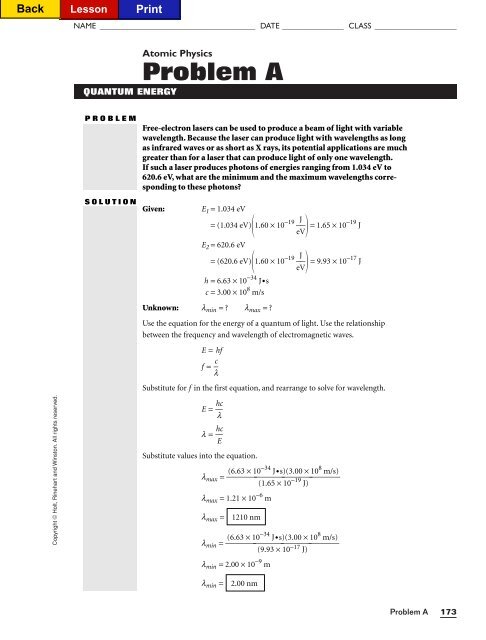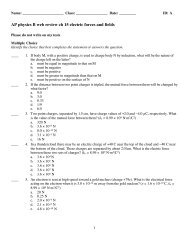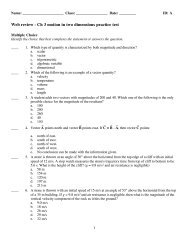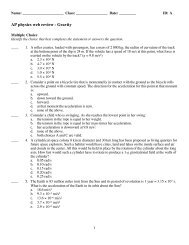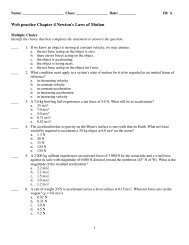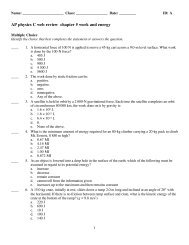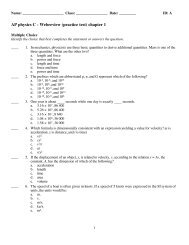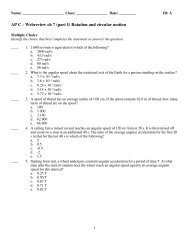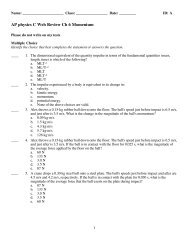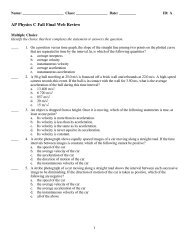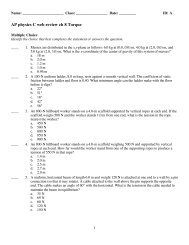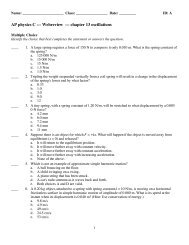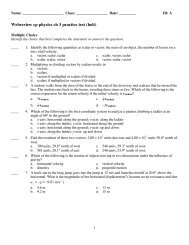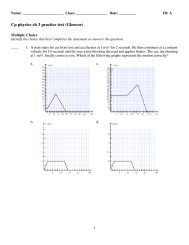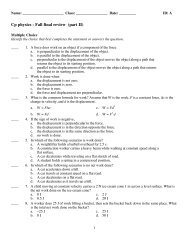Problem A Copyright reserved
quantum energy 1 - Planet Holloway
quantum energy 1 - Planet Holloway
Create successful ePaper yourself
Turn your PDF publications into a flip-book with our unique Google optimized e-Paper software.
NAME ______________________________________ DATE _______________ CLASS ____________________<br />
Atomic Physics<br />
<strong>Problem</strong> A<br />
QUANTUM ENERGY<br />
PROBLEM<br />
Free-electron lasers can be used to produce a beam of light with variable<br />
wavelength. Because the laser can produce light with wavelengths as long<br />
as infrared waves or as short as X rays, its potential applications are much<br />
greater than for a laser that can produce light of only one wavelength.<br />
If such a laser produces photons of energies ranging from 1.034 eV to<br />
620.6 eV, what are the minimum and the maximum wavelengths corresponding<br />
to these photons?<br />
SOLUTION<br />
Given: E1 = 1.034 eV<br />
= (1.034 eV) <br />
1.60 × 10 −19 ⎯ e<br />
JV ⎯ = 1.65 × 10−19 J<br />
E 2 = 620.6 eV<br />
= (620.6 eV) <br />
1.60 × 10 −19 ⎯ e<br />
JV ⎯ = 9.93 × 10−17 J<br />
h = 6.63 × 10 −34 J•s<br />
c = 3.00 × 10 8 m/s<br />
Unknown: l min = ? l max = ?<br />
Use the equation for the energy of a quantum of light. Use the relationship<br />
between the frequency and wavelength of electromagnetic waves.<br />
E = hf<br />
f = ⎯ l<br />
c ⎯<br />
Substitute for f in the first equation, and rearrange to solve for wavelength.<br />
<strong>Copyright</strong> © Holt, Rinehart and Winston. All rights <strong>reserved</strong>.<br />
E = ⎯ h c<br />
⎯<br />
l<br />
l = ⎯ h c<br />
⎯<br />
E<br />
Substitute values into the equation.<br />
(6.63 × 10 −34 J•s)(3.00 × 10 8 m/s)<br />
l max = ⎯⎯⎯⎯<br />
(1.65 × 10 −19 J)<br />
l max = 1.21 × 10 −6 m<br />
l max =<br />
1210 nm<br />
(6.63 × 10 −34 J•s)(3.00 × 10 8 m/s)<br />
l min = ⎯⎯⎯⎯<br />
(9.93 × 10 −17 J)<br />
l min = 2.00 × 10 −9 m<br />
l min =<br />
2.00 nm<br />
<strong>Problem</strong> A 173
NAME ______________________________________ DATE _______________ CLASS ____________________<br />
ADDITIONAL PRACTICE<br />
1. In 1974, IBM researchers announced that X rays with energies of<br />
1.29 × 10 −15 J had been guided through a “light pipe” similar to optic<br />
fibers used for visible and near-infrared light. Calculate the wavelength<br />
of one of these X-ray photons.<br />
2. Some strains of Mycoplasma are the smallest living organisms. The wavelength<br />
of a photon with 6.6 × 10 −19 J of energy is equal to the length of<br />
one Mycoplasma. What is that wavelength?<br />
3. Of the various types of light emitted by objects in space, the radio signals<br />
emitted by cold hydrogen atoms in regions of space that are located between<br />
stars are among the most common and important. These signals<br />
occur when the “spin” angular momentum of an electron in a hydrogen<br />
atom changes orientation with respect to the “spin” angular momentum of<br />
the atom’s proton. The energy of this transition is equal to a fraction of an<br />
electron-volt, and the photon emitted has a very low frequency. Given that<br />
the energy of these radio signals is 5.92 × 10 −6 eV, calculate the wavelength<br />
of the photons.<br />
4. The camera with the fastest shutter speed in the world was built for research<br />
with high-power lasers and can expose individual frames of film<br />
with extremely high frequency. If the frequency is the same as that of a<br />
photon with 2.18 × 10 −23 J of energy, calculate its magnitude.<br />
5. Wireless “cable” television transmits images using radio-band photons<br />
with energies of around 1.85 × 10 −23 J. Find the frequency of these<br />
photons.<br />
6. In physics, the basic units of measurement are based on fundamental physical<br />
phenomena. For example, one second is defined by a certain transition<br />
in a cesium atom that has a frequency of exactly 9 192 631 770 s −1 . Find<br />
the energy in electron-volts of a photon that has this frequency. Use<br />
the unrounded values for Planck’s constant (h = 6.626 0755 × 10 −34 J•s)<br />
and for the conversion factor between joules and electron volts (1 eV =<br />
1.602 117 33 × 10 −19 J).<br />
7. Consider an electromagnetic wave that has a wavelength equal to 92 cm,<br />
a length that corresponds to the longest ear of corn grown to date. What<br />
is the frequency corresponding to this wavelength? What is its photon<br />
energy? Express the answer in joules and in electron-volts.<br />
8. The slowest machine in the world, built for testing stress corrosion, can<br />
be controlled to operate at speeds as low as 1.80 × 10 −17 m/s. Find the<br />
distance traveled at this speed in 1.00 year. Calculate the energy of the<br />
photon with a wavelength equal to this distance.<br />
<strong>Copyright</strong> © Holt, Rinehart and Winston. All rights <strong>reserved</strong>.<br />
174<br />
Holt Physics <strong>Problem</strong> Workbook
<strong>Problem</strong> Workbook Solutions<br />
Additional Practice A<br />
Atomic Physics<br />
Givens<br />
1. E = 1.29 × 10 −15 J<br />
C = 3.00 × 10 8 m/s<br />
h = 6.63 × 10 −34 J•s<br />
Solutions<br />
l = ⎯ h c<br />
⎯ =<br />
E<br />
(6.63 × 10 −34 J•s)(3.00 × 10 8 m/s)<br />
⎯⎯⎯⎯<br />
1.29 × 10 −15 J<br />
l = 1.54 × 10 −10 m = 0.154 nm<br />
2. E = 6.6 × 10 −19 J<br />
C = 3.00 × 10 8 m/s<br />
h = 6.63 × 10 −34 J•s<br />
3. E = 5.92 × 10 −6 eV<br />
C = 3.00 × 10 8 m/s<br />
h = 6.63 × 10 −34 J•s<br />
l = ⎯ h c<br />
⎯ =<br />
E<br />
l = 3.0 × 10 −7 m<br />
l = ⎯ h c<br />
⎯ =<br />
E<br />
l = 0.210 m<br />
(6.63 × 10 −34 J•s)(3.00 × 10 8 m/s)<br />
⎯⎯⎯⎯<br />
6.6 × 10 −19 J<br />
(6.63 × 10 −34 J•s)(3.00 × 10 8 m/s)<br />
⎯⎯⎯⎯<br />
(5.92 × 10 −6 eV)(1.60 × 10 −19 J/eV)<br />
II<br />
4. E = 2.18 × 10 −23 J<br />
h = 6.63 × 10 −34 J •s<br />
E = hf<br />
f = ⎯ E h ⎯<br />
−23<br />
2.18<br />
× 10<br />
J<br />
f = ⎯⎯<br />
6 .63<br />
× 10−<br />
34 J •s<br />
f = 3.29 × 10 10 Hz<br />
<strong>Copyright</strong> © Holt, Rinehart and Winston. All rights <strong>reserved</strong>.<br />
5. E = 1.85 × 10 −23 J<br />
h = 6.63 × 10 −34 J •s<br />
6. f = 9 192 631 770 s −1<br />
h = 6.626 0755 × 10 −34 J •s<br />
1 eV = 1.602 117 33 × 10 −19 J<br />
7. l = 92 cm = 92 × 10 −2 m<br />
c = 3.00 × 10 8 m/s<br />
h = 6.63 × 10 −34 J •s<br />
h = 4.14 × 10 −15 eV •s<br />
f = ⎯ E −23<br />
h ⎯ =⎯ 1.85<br />
× 10<br />
J<br />
⎯ −34<br />
= 2.79 × 10 10 Hz<br />
6.63<br />
× 10<br />
J/ s<br />
E = hf<br />
E =<br />
(6.626 0755 × 10 −34 J •s)(9 192 631 770 s −1 )<br />
⎯⎯⎯⎯⎯<br />
1.602 117 33 × 10 −19 J/eV<br />
E = 3.801 9108 × 10 −5 eV<br />
f = ⎯ l<br />
c ⎯<br />
f = ⎯ 3. 8<br />
00<br />
× 10<br />
m/s<br />
⎯<br />
92<br />
× 10−<br />
2 m<br />
f =<br />
3.3 × 10 8 Hz = 330 MHz<br />
E = hf<br />
Section Two—<strong>Problem</strong> Workbook Solutions II Ch. 21–1
Givens<br />
Solutions<br />
E = (6.63 × 10 −34 J •s)(3.3 × 10 8 Hz)<br />
E =<br />
2.2 × 10 −25 J<br />
E = (4.14 × 10 −15 eV •s)(3.3 × 10 8 Hz)<br />
E = 1.4 × 10 −6 eV<br />
II<br />
8. v = 1.80 × 10 −17 m/s<br />
∆t = 1.00 year<br />
l =∆x<br />
c = 3.00 × 10 8 m/s<br />
h = 6.63 × 10 −34 J •s<br />
∆x = v∆t<br />
∆x = (1.80 × 10 −17 m/s)(1.00 year) <br />
⎯ 365 .25<br />
days<br />
24 h<br />
⎯<br />
1 year<br />
<br />
⎯⎯ 1 day<br />
<br />
⎯ 36 00s<br />
⎯<br />
1 h <br />
∆x =<br />
E = hf = ⎯ h c<br />
⎯<br />
l<br />
E =<br />
5.68 × 10 −10 m<br />
hc<br />
= ⎯⎯<br />
∆ x<br />
(6.63 × 10 −34 J •s)(3.00 × 10 8 m/s)<br />
⎯⎯⎯⎯<br />
5.68 × 10 −10 m<br />
E = 3.50 × 10 −16 J<br />
Additional Practice B<br />
1. hf t = 4.5 eV<br />
KE max = 3.8 eV<br />
h = 4.14 × 10 −15 eV•s<br />
f = [KE max + hf t ] [3.8<br />
eV<br />
+ 4.<br />
5 eV]<br />
=⎯⎯ h 4<br />
−15<br />
= 2.0 × 10 15 Hz<br />
.14<br />
× 10 eV•<br />
s<br />
2. hf t = 4.3 eV<br />
KE max = 3.2 eV<br />
h = 4.14 × 10 −15 eV •s<br />
3. hf t,Cs = 2.14 eV<br />
hf t,Se = 5.9 eV<br />
h = 4.14 × 10 −15 eV •s<br />
c = 3.00 × 10 8 m/s<br />
KE max = 0.0 eV for both<br />
cases<br />
KE max = hf − hf t<br />
f = ⎯ KE max + hf<br />
⎯ t<br />
h<br />
3.<br />
2 eV + 4.3<br />
eV<br />
f = ⎯⎯<br />
4.<br />
−15<br />
14<br />
× 10 eV<br />
•s<br />
f = 1.8 × 10 15 Hz<br />
a. KE max = hf − hf t = 0.0 eV = ⎯ h c<br />
⎯ − hf t<br />
l<br />
hc<br />
l = ⎯⎯<br />
h ft<br />
hc<br />
(4.14 × 10 −15 eV •s)(3.00 × 10 8 m/s)<br />
l Cs = ⎯⎯ = ⎯⎯⎯⎯<br />
hf t, Cs<br />
2.14 eV<br />
l Cs =<br />
5.80 × 10 −7 m = 5.80 × 10 2 nm<br />
<strong>Copyright</strong> © Holt, Rinehart and Winston. All rights <strong>reserved</strong>.<br />
hc<br />
(4.14 × 10 −15 eV •s)(3.00 × 10 8 m/s)<br />
b. l Se = ⎯⎯ = ⎯⎯⎯⎯<br />
hf t, Se<br />
5.9 eV<br />
l Se = 2.1 × 10 −7 m = 2.1 × 10 2 nm<br />
II Ch. 21–2<br />
Holt Physics Solution Manual


